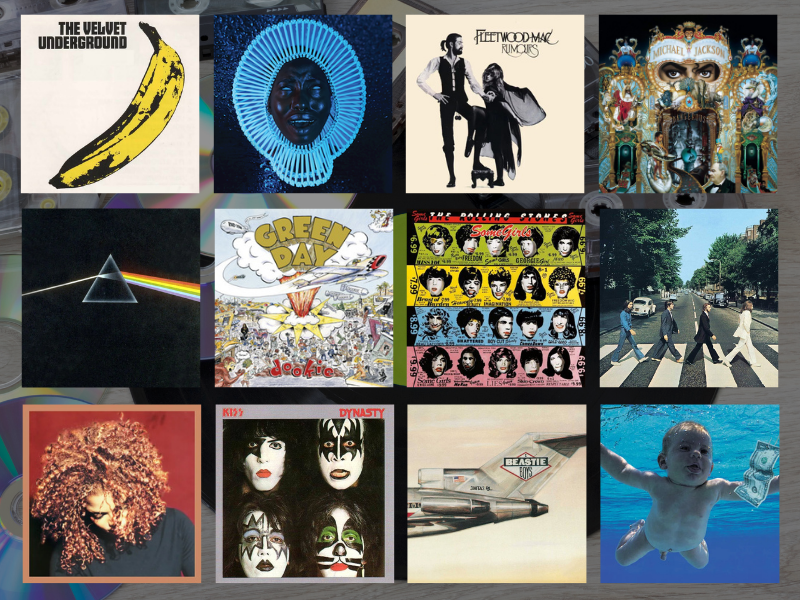Album Art Through The Ages — The Visual Evolution of Music

As the Grammy Awards ascend , celebrating the year’s best in music, it’s the perfect time to look back at how album artwork has evolved—and how it continues to shape the way we connect with our favorite artists.
The Birth of Album Art: 1940s–1950s
Before the 1940s, records were sold in plain brown wrappers—functional, but hardly artistic. That changed when Columbia Records’ Alex Steinweiss introduced the concept of illustrated album covers. His designs, often featuring vibrant, stylized typography and surreal imagery, transformed record packaging into an art form.
Notable Examples:
🎶 Frank Sinatra – In the Wee Small Hours (1955) – A moody, painted illustration that set the standard for introspective album covers.
🎶 Miles Davis – Birth of the Cool (1957) – A sleek, modern design that matched the smooth sophistication of Davis’ sound.
The Psychedelic & Conceptual Era: 1960s–1970s
As music evolved, so did album covers. The 1960s and 70s ushered in the era of psychedelic colors, surreal imagery, and elaborate designs. Bands and artists started using album art to reflect the themes of their music, sometimes turning covers into full-fledged works of art.
Notable Examples:
🎸 The Beatles – Sgt. Pepper’s Lonely Hearts Club Band (1967) – A collage of famous figures surrounding the Fab Four, creating one of the most iconic covers ever.
🎸 Pink Floyd – The Dark Side of the Moon (1973) – A minimalist prism design that became an instantly recognizable symbol of rock history.
🎸 David Bowie – Aladdin Sane (1973) – Bowie’s lightning-bolt-covered face became an emblem of glam rock and artistic reinvention.
The Bold, Edgy, and Minimalist Years: 1980s–1990s
The 80s and 90s saw a shift in album art—some covers were loud and in-your-face, while others were stripped down and simple. With the rise of punk, hip-hop, and electronic music, artists pushed creative boundaries even further.
Notable Examples:
🎤 Prince – Purple Rain (1984) – A dramatic, film-like cover that matched the album’s cinematic sound.
🎤 Nirvana – Nevermind (1991) – A striking underwater image that became one of the most famous album covers in rock history.
🎤 The Notorious B.I.G. – Ready to Die (1994) – A simple yet powerful photo of a baby, symbolizing themes of innocence and survival.
Digital Age & The Future of Album Covers: 2000s–Present
In the age of streaming, album covers have become more about branding and digital aesthetics than physical packaging. Some artists stick to bold, eye-catching visuals, while others embrace subtle, almost cryptic designs.
Notable Examples:
🎶 Kanye West – My Beautiful Dark Twisted Fantasy (2010) – A cover so provocative that some versions were censored.
🎶 Beyoncé – Beyoncé (2013) – A minimalist black cover with simple pink text, signaling a new era of surprise album drops.
🎶 Billie Eilish – When We All Fall Asleep, Where Do We Go? (2019) – A haunting, surreal portrait that visually captures her eerie, dreamlike music.
Album Art & The Grammys: The Intersection of Music & Visual Creativity
Album art continues to be a crucial part of an artist’s identity—and it’s even recognized at the Grammy Awards, where categories like Best Recording Package celebrate standout visual design. With today’s artists pushing creative boundaries both musically and visually, album covers remain just as relevant as ever.
So, as we gear up for the 2025 Grammy Awards, keep an eye out for this year’s most innovative and striking album covers. Who knows? One of today’s standout designs could be the next Sgt. Pepper or Dark Side of the Moon—a visual statement that defines an era.
Share Billboard's List of 100 Best Album Covers | Come Paint With Us!

